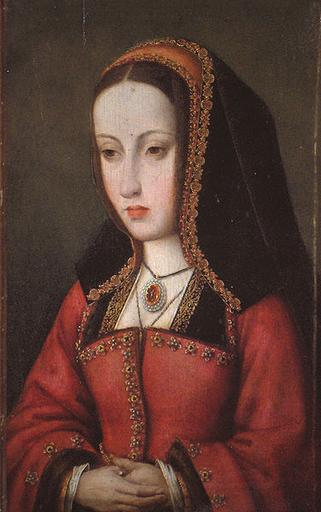MAKE A MEME
View Large Image

| View Original: | Juana_of_Castile,_Sister_of_Catherine_of_Aragon.jpg (376x600) | |||
| Download: | Original | Medium | Small | Thumb |
| Courtesy of: | www.flickr.com | More Like This | ||
| Keywords: catherine of aragon catherineofaragon european royalty europeanroyalty portrait people indoor Upon the death of Isabella of Castile in November 1504, Joanna became Queen regnant of Castile, and her husband de jure uxoris King; Joanna's father, Ferdinand, lost his title of 'King of Castile', although his wife's will permitted him to govern the country in Joanna's absence, or, if Joanna was unwilling to rule it herself, until Charles reached the age of 20. Ferdinand refused to accept this: he minted Castilian coins in the name of "Ferdinand and Joanna, King and Queen of Castile, Léon and Aragon", and in early 1505 persuaded the Cortes that Joanna's "illness...is such that the said Queen Doña Juana our Lady cannot govern"; the Cortes then appointed Ferdinand as Joanna's guardian, and as administrator and governor of the kingdom. However, Philip the Handsome was unwilling to accept any threat to his own chances of ruling Castile, and this way, he also coined coins in name of "Philip and Joanna, King and Queen of Castile, Léon and Archdukes of Austria, etc".[8] In response Ferdinand embarked upon a pro-French policy, marrying Germaine de Foix, the niece of Louis XII of France (and his own great-niece), in the hope that she would produce a son to inherit Aragon, and perhaps Castile. [9] Ferdinand's remarriage merely strengthened support for Philip and Joanna in Castile, and in late 1505 the pair decided to travel to Castile. Leaving Flanders on 10 January 1506, their ships were wrecked on the English coast and the couple became guests of Henry VII at Windsor Castle. They were only able to leave on 21 April, by which time civil war was looming in Castile: Philip apparently considered landing in Andalusia and summoning the nobles to take up arms against Ferdinand. Instead, he and Joanna landed at Coruña on 26 April, upon which the Castilian nobility abandoned Ferdinand en masse. Ferdinand then met with Philip at Villafafila on 20 June 1506, and handed over the government of Castile to his "most beloved children", promising to retire to Aragon. Philip and Ferdinand then signed a second treaty, agreeing that Joanna's mental instability made her incapable of rule, and promising to exclude her from government. Ferdinand then proceeded to repudiate the agreement on the same afternoon, declaring that Joanna should never be deprived of her rights as Queen Proprietress of Castile. A fortnight later, having come to no fresh agreement with Philip, and thus effectively retaining his right to interfere if he considered his daughter's rights to be infringed, he abandoned Castile, leaving Philip to govern in Joanna's stead. Upon the death of Isabella of Castile in November 1504, Joanna became Queen regnant of Castile, and her husband de jure uxoris King; Joanna's father, Ferdinand, lost his title of 'King of Castile', although his wife's will permitted him to govern the country in Joanna's absence, or, if Joanna was unwilling to rule it herself, until Charles reached the age of 20. Ferdinand refused to accept this: he minted Castilian coins in the name of "Ferdinand and Joanna, King and Queen of Castile, Léon and Aragon", and in early 1505 persuaded the Cortes that Joanna's "illness...is such that the said Queen Doña Juana our Lady cannot govern"; the Cortes then appointed Ferdinand as Joanna's guardian, and as administrator and governor of the kingdom. However, Philip the Handsome was unwilling to accept any threat to his own chances of ruling Castile, and this way, he also coined coins in name of "Philip and Joanna, King and Queen of Castile, Léon and Archdukes of Austria, etc".[8] In response Ferdinand embarked upon a pro-French policy, marrying Germaine de Foix, the niece of Louis XII of France (and his own great-niece), in the hope that she would produce a son to inherit Aragon, and perhaps Castile. [9] Ferdinand's remarriage merely strengthened support for Philip and Joanna in Castile, and in late 1505 the pair decided to travel to Castile. Leaving Flanders on 10 January 1506, their ships were wrecked on the English coast and the couple became guests of Henry VII at Windsor Castle. They were only able to leave on 21 April, by which time civil war was looming in Castile: Philip apparently considered landing in Andalusia and summoning the nobles to take up arms against Ferdinand. Instead, he and Joanna landed at Coruña on 26 April, upon which the Castilian nobility abandoned Ferdinand en masse. Ferdinand then met with Philip at Villafafila on 20 June 1506, and handed over the government of Castile to his "most beloved children", promising to retire to Aragon. Philip and Ferdinand then signed a second treaty, agreeing that Joanna's mental instability made her incapable of rule, and promising to exclude her from government. Ferdinand then proceeded to repudiate the agreement on the same afternoon, declaring that Joanna should never be deprived of her rights as Queen Proprietress of Castile. A fortnight later, having come to no fresh agreement with Philip, and thus effectively retaining his right to interfere if he considered his daughter's rights to be infringed, he abandoned Castile, leaving Philip to govern in Joanna's stead. | ||||